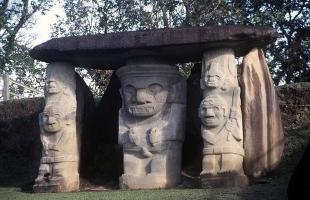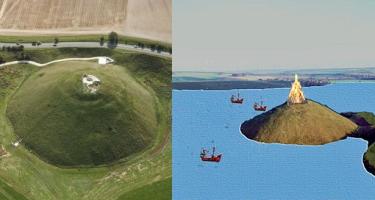Copy Link
Add to Bookmark
Report
impr9204

+++++++++++++++++++++++++++++++++++++++++++++++++++++++
IS THIS AN UNTAMPERED FILE?
This ASCII-file version of Imprimis, On Line was packaged by
Applied Foresight, Inc. (AFI hereafter). Every AFI-packaged
ASCII version of Imprimis is distributed in an "-AV protected"
ZIP file format. "AV" is the authenticity verification feature
provided to registered PKZIP users, which Applied Foresight,
Inc., is. If you are using the MS-DOS PKUNZIP.EXE program
written by PKWARE Inc. and do not see the "-AV" message after
every file is unzipped AND receive the message "Authentic files
Verified! # JAA646 ZIP Source: Applied Foresight Inc. (CIS
71510,1042)" when you unzip this file then do not trust it's
integrity. If your version of PKUNZIP is not the PKWARE-
authored program (for instance, you are running a non-MS-DOS
version), then this message may not be displayed.
Trust only genuine AFI-packaged archives ... anything else may
be just that: ANYTHING ELSE.
+++++++++++++++++++++++++++++++++++++++++++++++++++++++++++++++
Imprimis, On Line -- April 1992
Imprimis, meaning "in the first place," is a free monthly
publication of Hillsdale College (circulation 360,000
worldwide). Hillsdale College is a liberal arts institution
known for its defense of free market principles and Western
culture and its nearly 150-year refusal to accept federal
funds. Imprimis publishes lectures by such well-known
figures as Ronald Reagan, Jeane Kirkpatrick, Tom Wolfe,
Charlton Heston, and many more. Permission to reprint is
hereby granted, provided credit is given to Hillsdale
College. Copyright 1992. For more information on free print
subscriptions or back issues, call 1-800-437-2268, or 1-517-
439-1524, ext. 2319.
--------------------------------------------------
"Slouching Toward Catastrophe: 1914-1939"
by George H. Nash, Author, Presidential Biographer
--------------------------------------------------
Volume 21, Number 4
Hillsdale College, Hillsdale, Michigan 49242
April 1992
---------------
Preview: The year 1992 marks the 50th anniversary of
America's entry into World War II, the most titanic struggle
in human history. Nearly every nation and every people were
involved. When it was over, more than 50 million soldiers
and civilians were dead, as were whole nations whose borders
would be redrawn in the succeeding era. It came, ironically
enough, on the heels of another war, the one that was to be
"the war to end all wars." In reality, however, World War I
was only a dress rehearsal for a far more cataclysmic event.
Here, historian George Nash explains why. His remarks were
delivered during the Center for Constructive Alternatives
seminar, "America's Entry into World War II," in November
1991.
---------------
Seventy-three years ago, the First World War ended in
Europe. The armistice took effect at eleven o'clock in the
morning -- the eleventh hour of the eleventh day of the
eleventh month: a symbolic acknowledgement that European
civilization had come close to irreversible ruin.
The Great War, as men and women then called it, had been
a conflict like none other in history. It had begun in the
summer of 1914, when 20,000,000 European men had put on
their uniforms, boarded trains, and headed off to
preassigned battle stations. At the time, the British
foreign secretary had remarked, "The lamps are going out all
over Europe; we shall not see them lit again in our
lifetime." The men who marched believed, as the German
Kaiser and others promised, that they would be home "before
the leaves fell." Instead, they fell, in dark, unimaginable
encounters like the battle of Verdun, which lasted for ten
months and took 850,000 French and German lives. They fell
in battles like that of the Somme, on whose very first day
(July 1, 1916) the British army suffered 60,000 casualties,
including 20,000 dead. By the time "the war to end wars"
ceased, 10,000,000 people had died. In its final months a
great pandemic of Spanish influenza swept over much of an
exhausted globe. By the time the scourge subsided,
20,000,000 more people had died, including half a million in
the United States.
Less than a quarter of a century later, the Great War
had its name changed. Now a numeral -- number I -- was
affixed, as nations embarked upon a second and even more
titanic struggle, rightly described as "the largest single
event in human history." Fifty million people died before it
ended; nearly half of them were civilians. In the United
States alone, more than 12,000,000 men and women wore
uniforms.
In duration, scale of combat, the expanse of theaters of
operations, the number of casualties, and physical damage,
the Second World War clearly dwarfed the First. But the
psychic wounds of the earlier war, it seems to me, went
deeper, and it is this dimension that I wish to explore this
afternoon. It is not my purpose today to chronicle the
diplomatic maneuvering that culminated in the German assault
on Poland in 1939 or the Japanese attack on Pearl Harbor two
years later. Still less is it my purpose systematically to
analyze the immediate origins, both great and small, of
those events. I propose instead to examine some of the ways
in which the experience of the First World War affected the
coming of the Second. You may ask why I do so. Because, in
the words of the British historian A.J.P. Taylor: "The first
war explains the second and, in fact, caused it, in so far
as one event causes another." We cannot fully understand the
horrific conflagration of 1939-1945 unless we fathom some of
the psychological and intellectual impulses that the earlier
war released and that then shaped the consciousness of
Europe and America for twenty years.
The Trench
Every war produces its distinctive engravings on our
collective memory. Consider the recent Persian Gulf war, for
example: Who among us will ever forget the television
pictures of Patriot missiles intercepting SCUDs, or the clip
of General Schwartzkopf scorning Saddam Hussein's
pretensions to military greatness? Look back now to the
Second World War; what images arise? Hitler shrieking before
a Nazi Party rally; Churchill defiant against the enemy;
bombs falling over London during the Blitz; the rubble of
Stalingrad; the beaches of Normandy; Pearl Harbor;
Hiroshima; Auschwitz. When we search for mental pictures of
the First World War, however, I suspect that most of us will
think of only one: a trench. This remains the dominant
symbol of the Great War -- a fact that tells much about that
war and about what came after it.
From the autumn of 1914 until the autumn of 1918, the
armies of the Allies and of Germany faced each other in a
labyrinth of trenches stretching in parallel for more than
four hundred miles from the English Channel, across Belgium
and France, to the Swiss frontier. On each side the trenches
were of three kinds: frontline trenches, theoretically six
to eight feet deep (or more) and four to five feet wide, and
sometimes only forty yards from the enemy; support trenches
a few hundred yards back; and reserve trenches farther back
still. Connecting these three rows were communication
trenches that ran at right angles to them. In all, the
belligerents constructed approximately 25,000 miles of
trenches -- enough, if laid end to end, to encircle the
globe. In these dismal, often wet, rat-infested, lice-packed
tunnels, several million men spent the war. Between them lay
a desolate shell-marked quagmire filled with barbed wire and
known as No Man's Land.
For nearly four years the competing armies tried to
break out of the ghastly stalemate -- by going "over the
top" and attempting to rout the enemy. Nothing worked.
Millions died or were wounded without militarily significant
results. The combatants tried shelling each other in order
to destroy the barbed wire and force the evacuation of the
opposing trenches. At the battle of the Somme the British
fired 1,700,000 artillery shells before the charge began.
The principal effect was to make it impossible for their
infantry to advance quickly through the churned-up mud.
Almost always it was the attackers who lost more men. Secure
in his own redoubts, the enemy had only to wait until the
opposing soldiers abandoned their shelters and tried to slog
across No Man's Land. If the enemy's return bombardment did
not mow them down, his machine guns did. The machine gun was
the great defensive weapon of World War I.
Herbert Hoover, at the time an American engineer who
directed an unprecedented international relief program in
German-occupied Belgium during the war, witnessed one of
these battles from a vantage point behind German lines. He
never forgot what he saw:
"We motored for several hours to a point near a hilltop
observation post in the forest, a distance back from the
forward trenches and a mile or two away from the main roads.
During the last few miles an occasional shell cracked nearby
but the ingenious camouflage of the road -- to the extent of
a false parallel -- seemed to give protection to our route.
At the post the constant rumble of artillery seemed to
pulverize the air. Seen through powerful glasses, in the
distant view lay the unending blur of trenches, of volcanic
explosions of dust which filled the air where over a length
of sixty miles a million and a half men were fighting and
dying. Once in a while, like ants, the lines of men seemed
to show through the clouds of dust. Here under the thunder
and belching volcanoes of 10,000 guns, over the months of
this battle, the lives of Germans and Englishmen were thrown
away. On the nearby road unending lines of Germans plodded
along the right side to the front, not with drums and bands,
but in the silence of sodden resignation. Down the left side
came the unending lines of wounded men, the 'walking cases'
staggering among cavalcades of ambulances. A quarter of a
million men died and it was but one battle in that war.
"The horror of it all did not in the least affect the
German officers in the post. To them it was pure mechanics.
Not one of the Germans showed the slightest anxiety. They
said that the British were losing two to one -- butting
their heads against a stone wall. And that was true. It was
all a horrible, devastating reality, no romance, no glory."
Hoover's reaction was representative. The experience of
the trenches became for many the dominant memory of the war
-- the abiding symbol of unutterable horror and waste. In
the 1920s, after the euphoria of Armistice Day had long
since passed away, a mood of disillusionment with the war
took hold in many sectors of European and American life. It
spread from the "lost generation" of European soldiers,
unable to readjust to civilian occupations, on to poets,
painters and novelists. It was reflected in artistic
phenomena like the nihilistic Dada movement and surrealism
(the very word surrealism was invented by a French poet and
soldier in 1917). It was evident in the cultural despair
that eventuated, among other things, in the French
existentialism of the late 1930s. We can detect it, too, in
the frenetic hedonism that Americans associate with the
Roaring Twenties; in the early novels of Fitzgerald,
Faulkner and Hemingway; in the poetry of Siegfried Sassoon
and the early T. S. Eliot (whose poem The Wasteland became
another symbol of the age); and in the febrile decadence of
late Weimar Germany, so effectively conveyed in the movie
Cabaret.
Nowhere, perhaps, was the perceived futility of the war
more shockingly depicted than in the novel All Quiet on
the Western Front, written by a German veteran, Erich Maria
Remarque, and published in 1929. There is no glory or
grandeur in this tale. It is a story of endless death
without meaning. Visiting a hospital full of wounded
soldiers, the narrator is driven to suggest that Western
civilization has no worth:
"How senseless is everything that can ever be written,
done, or thought, when such things are possible. It must be
all lies and of no account when the culture of a thousand
years could not prevent this stream of blood being poured
out, these torture-chambers in their hundreds of thousands.
A hospital alone shows what war is."
Remarque's novel was intended to be the cri de coeur of
the "lost generation." Critics hailed it as "the truth about
the war." In just fifteen months it sold 3,500,000 copies in
several languages -- a record without precedent in several
centuries of book publishing.
Disillusionment Among the Victors
All Quiet on the Western Front undoubtedly abetted a
wave of pacifistic revulsion that peaked in the early 1930s
in the principal countries that won the war. This sentiment
had some curious manifestations. In the Kellogg-Briand Pact
of 1928, for instance, sixty-two nations, including the
United States, the Soviet Union, and Germany, solemnly
renounced war "as an instrument of national policy in their
relations with one another," and pledged instead to settle
all their disputes only by "pacific means." To some
enthusiasts it appeared that the signatories had "outlawed
war." The treaty contained no provision for enforcement; it
was hoped that public opinion would deter violations. In
1933 the Oxford Union -- a prestigious undergraduate
debating society comprising the future political leaders of
Great Britain -- resolved "That this House refuses in any
circumstances to fight for King and Country." The vote
precipitated a national uproar and may have encouraged Adolf
Hitler to believe that the British would not resist his
expansionism. In the United States in 1934, a sensational
investigation led by Senator Gerald Nye purported to
discover that leading American bankers and arms dealers --
the so-called "merchants of death" -- had maneuvered Woodrow
Wilson into entering World War I in order to save their ill-
gotten profits and loans to the Allied governments. The Nye
Committee hearings helped to persuade many Americans that
they should never have fought in the Great War at all and
that they should now withdraw from entanglements with an
incorrigible Europe. One result was Congressional passage of
neutrality laws designed to keep America out of the Old
World's quarrels.
By portraying the war as a pointless exercise in
brutality, All Quiet on the Western Front also may have
strengthened the growing appeal of historical revisionists,
who argued that Germany was not solely responsible for the
terrible conflict. But if this were true -- if the war in
fact had no decisive moral content -- then were not all the
combatant nations morally equivalent? And if that were so,
how could the winners object to Germany's campaign in the
1930s to subvert and ultimately repudiate the Treaty of
Versailles? The pacifist mood in the Allied nations helped
to shift the burden of guilt (or at least of doubt) from the
vanquished to the victors, thereby inhibiting willingness to
rearm.
Revenge Among the Defeated
And now we come to a sobering complication: not everyone
who witnessed the carnage of World War I regarded it as the
ultimate evil. If the war experience and its aftermath at
Versailles induced disillusionment in the victorious Allies,
the specific terms of the settlement evoked in the defeated
Germans a profound resentment and thirst for revenge. Not
only did the hated treaty oblige Germany to acknowledge her
guilt for starting the war -- an admission that, however
true, seemed manifestly unfair -- it also deprived Germany
of all her colonies, nearly half of her iron production, 13
percent of her prewar territory, and 12 percent of her
population. It also reduced her army to a mere 100,000 men,
forbade it to possess tanks or airplanes, and required the
Germans to pay immense reparations to the Allies. And it
divided the German state of Prussia by permitting the new
country of Poland a so-called "corridor" to the Baltic Sea.
Historians still debate whether the Treaty of Versailles
was too harsh. What strikes this historian is the tremendous
gap that ordinary Germans perceived between their
circumstances on the battlefield at the time of the
Armistice and the final provisions of the Treaty eight
months later. In November 1918, when the fighting ceased,
Germany was not a conquered nation. In fact, she had just
won the war in the East and had compelled her enemy, Russia,
to cede vast territories at the Treaty of Brest-Litovsk. On
the western front, at the Armistice, the German army was in
retreat, but it had not been destroyed as a fighting force.
In fact, at the ceasefire on November 11 it still stood on
foreign soil. The Kaiser's army had definitely lost the war
in the West (hence the German request for an armistice). But
except for certain generals and high government officials,
the German people did not know that they had been beaten.
Thus the ultimate terms of the Versailles treaty, when they
were promulgated several months later, appeared to most
Germans to be unbelievably punitive and incommensurate with
the result of the contest of arms. This perception was
false, but it permitted Adolf Hitler and many others,
including German army leaders who knew better, to foment the
insidious legend of "the stab in the back": that is, the
claim that Germany had not been defeated on the battlefield
but had instead been betrayed from within. By whom? By the
"November criminals" who had demanded an armistice and then
acquiesced in the draconian treaty. By the socialists, the
Communists, the Jews, and all who supported the Weimar
republic created out of the ashes of defeat. "Down with the
perpetrators of the November crime," Hitler said in one of
his early speeches. "We must not forget that between us and
those betrayers of the people [the Weimar
government]...there are two million dead." For Hitler and
countless other Germans, the war itself had not been
meaningless. Rather, an unjust and humiliating peace had
deprived them of their land, freedom, property, and their
place in the sun.
So Hitler clamored untiringly for vengeance, for
repudiation of Versailles and the noxious European order
built upon it. Germany must rise again. He was not alone in
his hate. The general sentiment was shared by most of his
countrymen. In 1929 the German government declared June 28 -
- the tenth anniversary of the treaty -- to be a day of
national mourning.
Thus were set in motion two conflicting streams of
consciousness -- and a deep, almost fatal dissonance between
Allied guilt and German revanchism. For many in the Allied
nations, the peace that followed the First World War was not
good enough to justify the sacrifices in the trenches. For
all too many Germans, the peace seemed worse than the war.
In 1933, only months after the "best and the brightest"
Oxford students were pledging never to fight for king or
country, the new Nazi government seized and destroyed copies
of All Quiet on the Western Front. At the University of
Berlin, it was tossed into a bonfire. As a Nazi student did
so, he said, "Down with the literary betrayal of the
soldiers of the world war! In the name of educating our
people in the spirit of valor, I commit the writings of
Erich Maria Remarque to the flames."
The Great War did more than generate disillusionment,
cultural pessimism, and pacifism among the victors, and
kindle a desire for retaliation among the defeated Germans.
It also encouraged military planners to devise new modes of
warfare so that when the next war came there would be no
wanton squandering of lives in a maze of impenetrable
trenches. During the First World War, the British had
actually invented such a weapon -- the tank -- but had used
it hesitantly and ineffectively. In the next war, tanks
would be infinitely more prominent. During the Twenties and
Thirties military men, especially in Germany, developed air
power -- another alternative to the trench -- to a point
that many predicted the incineration of entire cities in the
first hours of any new conflict. In this area, as in other
realms of technology, the Nazis pioneered. Trench warfare,
Hitler declared, was "degenerate"; air warfare, he said, was
a Germanic way to fight.
Thanks in part, then, to technological developments, and
in part to rancid memories of the First World War, the
second global conflict was to be much more mobile and
mechanized. The word blitzkrieg would enter the vocabulary.
In the second war, the search for what one historian has
called "revolutionary weapons" would accelerate,
culminating, of course, in the atomic bomb.
Here I call your attention to a curious fact. In certain
respects the last great battle of World War II -- the battle
of Okinawa -- most resembled the grim encounters on the
Western front in World War I. On this Pacific Ocean island,
almost eighty miles long, invading American soldiers had to
go "over the top" -- that is, from the exposed sandy beaches
where they went ashore up into the rugged hills and
mountains, where desperate Japanese had entrenched
themselves in tunnels, caves and other well-guarded
fortifications. The American army and marines had to advance
upon ridge after ridge, defended by Japanese fighting with
manic ferocity. In the end, 35 percent of the American army
troops and marines who fought at Okinawa were killed or
wounded. One hundred ten thousand Japanese soldiers died --
many by suicide -- rather than suffer the humiliation of
surrender. This enormous loss of life and the fanatical
character of the Japanese resistance convinced American
military leaders that the impending invasion of the Japanese
home islands would cost the American army a million
casualties. This was a principal reason for the decision to
drop the atomic bomb on Hiroshima. For American soldiers
there would be no repetition of the slaughter, twenty-seven
years before, in northern France.
Clash of Ideologies
Let me return to the experience of 1914-1918 and certain
other of its consequences. The First World War began as a
clash of empires. It ended amidst a clash of ideologies. One
of these was liberal, democratic internationalism,
propounded by its prophet, Woodrow Wilson. "The world must
be made safe for democracy," he proclaimed in his address
asking Congress to declare war. For many Americans the
struggle became a transcendent contest, not between
governments, but between principles: between democracy and
autocracy, democracy and Prussianism, the principle of self-
determination and the notion that "might makes right." "What
we demand in this war," said Wilson in January 1918,
"...is nothing peculiar to ourselves. It is that the
world be made fit and safe to live in; and particularly that
it be made safe for every peace-loving nation which, like
our own, wishes to live its own life, determine its own
institutions, be assured of justice and fair dealing by the
other peoples of the world as against force and selfish
aggression."
After listing fourteen components of a just settlement
(his soon-to-be famous "Fourteen Points"), the President
concluded that a single transcendent principle undergirded
them: "It is the principle of justice to all peoples and
nationalities, and their right to live on equal terms of
liberty and safety with one another, whether they be strong
or weak. Unless this principle be made its foundation no
part of the structure of international justice can stand."
The current war, he declared, was "the culminating and final
war for human liberty." Americans, he said, were ready to
give everything to vindicate the principle for which they
fought.
In the words of Woodrow Wilson's preeminent biographer,
the Fourteen Points address was "the single great manifesto
of World War I." Here was a vision that seemed to redeem the
frightful slaughter and beckon mankind to a truly better
world. Not everyone was carried away by Wilson's eloquence,
however. The crusty old French premier Clemenceau -- of whom
it was said that he had one illusion (France) and one
disillusion (mankind) -- was one. Of the Fourteen Points, he
remarked, "The good Lord had only ten." Clemenceau and other
Allied statesmen had their own, less lofty conceptions of
what the postwar international order should become.
Nevertheless, for a brief moment in late 1918 and 1919,
Wilson was ac-claimed in much of Europe as a veritable
secular savior of the world.
Of course, we all know what happened next: Wilson failed
to implement his vision. His compromises at the Versailles
peace conference disillusioned much of the American Left.
His abstract professorial universalism disturbed the
American Right. Nevertheless, Wilson's fundamental principle
of the self-determination of peoples remained potent. It
became one of the enduring revolutionary legacies of World
War I -- indeed, one of the catalytic doctrines of the
twentieth century. (Just a few months ago it provided part
of the rationale for the American liberation of Kuwait.)
Unfortunately, not all the ideologies that emerged from
the cauldron of the Great War were so altruistic in their
intentions. Two of them, alas, were demonic. They were, in
fact, ideologies not of peacemaking but of struggle.
The first of these -- revolutionary Marx-ism -- was not
new; it had been around for more than half a century. But in
the hands of V.I. Lenin it now became more than a coffee
house theory. Lenin had never been in the trenches. He had
spent much of the war in exile in Switzerland plotting -- at
the time it seemed futilely -- against the Czar. While he
condemned the Great War as an imperialistic adventure and
exploited weariness with it to the hilt, he had no aversion
to violence per se. He merely sought a different kind of
violence -- an international working class uprising against
the bourgeoisie. Then, he believed, global harmony would
come. Woodrow Wilson wanted the First World War to end war;
Lenin wanted an even greater war first.
Once he seized power, the Bolshevik leader implemented
his conception of politics-as-war with all-encompassing
ruthlessness. Long before he became master of Russia, he had
said: "In principle we have never renounced terror and
cannot renounce it." For Lenin only one question mattered:
"We'll ask the man, where do you stand on the question of
the revolution? Are you for it or against it? If he's
against it, we'll stand him up against a wall." Let no one
ever tell you that the Gulag Archipelago originated with
Josef Stalin. Within months of the Bolshevik coup in
November 1917, Lenin himself and his willing cohorts had
created a secret police, had established embryonic
concentration camps, and had instituted an unending wave of
political executions. In January 1918 he personally ordered
the departments of his government to "purge the Russian land
of all kinds of harmful insects." This was not hyperbole; he
meant it. By the time of his death in 1924, Lenin had
willfully and remorselessly created an unparalleled system
of internal warfare against his own people. And thus, out of
the maw of the "the war to end wars," there arose a hideous
new form of warfare: perpetual institutionalized terror
against one's own citizens, even to the point of
exterminating them. We now call it totalitarianism.
In this connection, I will never forget a conversation
that I had in graduate school with some fellow students, one
of them a Marxist who resolutely defended the Soviet Union.
Finally, an exasperated friend of mine asked: what about
Stalin's liquidation of the kulaks, the enterprising
peasants who were killed by the millions in the early 1930s?
The Marxist replied simply: "They never should have existed
as a class."
Leninism was a beneficiary, though not a direct product,
of the war in the trenches. To a significant degree, the
other ideological demon unleashed by the war was. I refer,
of course, to the phenomenon of Nazism. If for the Allies
and the United States the ultimate lesson of the trench
experience was "No more war," and if for Lenin and the
Bolsheviks the lesson was "One more war," for Adolf Hitler
the fundamental meaning of 1914-1918 was different. Unlike
Lenin, Hitler had been a denizen of the trenches. For about
four years he fought on the Western front and found the
experience to be the most gratifying of his life. What was
not satisfying to him was its ending.
Historians have noted many similarities between
Bolshevism and Nazism, and between their respective founding
fathers. Like Lenin, Hitler was a revolutionary and a self-
proclaimed socialist, although his variant was called
"national socialism" rather than international. Like Lenin,
Hitler was anti-Christian and totally without moral
scruples. Like Lenin, he conceived of politics in military
terms and instituted an apparatus of state violence never
before seen on earth. But whereas for Leninists the meaning
of existence was class struggle, for Nazis the engine of
history was racial struggle. In short, and, again, as other
historians have observed, Hitler's world view was a form of
Social Darwinism -- the notion, put crudely, of "the
survival of the fittest." For Hitler and his followers, the
essence of social evolution was not economic but ethnic.
We need not linger over the odious contents of Nazi
ideology: the idea that Germans or "Aryans" were the "master
race" who should dominate the world; that Slavs were
inferior and must become slaves; that the German Volk needed
lebensraum in the East, all the way to Iran; that the Jews
(in Hitler's word) were "vermin" who must be destroyed. Nor
need we do more than take note of the fact that for millions
of German war veterans and others, Nazi symbolism -- the
uniforms, the parades, the salutes, the flags, the
regimented rallies at night -- recreated what was called
"the community of the trenches." In a sense, Hitler wanted
to renew World War I. But what deceived many in the West was
the belief that all he wanted was to reverse the inequities
of Versailles and to restore the German nation to prominence
in Europe. Transfixed by the trench experience, many could
not imagine that Hitler desired all that -- and much more.
I do not wish to imply that the racism inherent in
Hitler's brand of socialism was somehow peculiar to central
Europe in the two decades between the world wars. Racial
stereotyping was not new, nor was it confined to the Old
World. Many Americans, for example, despised and
discriminated against Japanese immigrants. Many Japanese
boasted of their racial "purity," asserted their "divine
mission" to rule over Asia, referred to the Chinese as
"chinks," and yearned for the day when, as one of their
admirals put it, they "could return Admiral Perry's visit."
No, ethnic chauvinism was neither new nor localized. What
was different after 1918 was that in a number of so-called
"have-not" countries, attitudes of racial superiority become
transmogrified into "armed doctrines" -- rationales for
genocide and war without pity.
The First World War, then, gave birth to the Ideological
Age. Perhaps this outcome was inevitable in the aftermath of
perceived civilizational collapse. Most political
ideologies, after all, aim in some way to remake the world.
What else but a "purified" world could erase the memory of
the bloodletting of the Great War?
In the movie Cabaret there is a chilling scene in which
a fair-haired German youth sings to a crowd at an outdoor
restaurant in the waning days of Weimar. As the camera
turns, we see that he is wearing a Nazi uniform and swastika
on his armband. He is cheerful. He is confident. His song
ends with the words: "Tomorrow belongs to me." This, too,
was part of the allure of the two evil ideologies that laid
siege to Europe's soul after the Armistice. Yesterday, the
war; today, corruption and shame; but "tomorrow belongs to
me." This is the false promise of all totalitarians: that
the future will atone for the crimes committed in its name.
Conclusion
This has been, of necessity, a somber lecture, and it
has not been possible to consider all the intellectual and
spiritual consequences of World War I. Other important
phenomena of the period come to mind, such as the influence
of wartime collectivism on the response of the United States
and other countries to the Great Depression. Instead, my
focus has been on the direct antecedents of World War II --
specifically, the great currents of thought and sentiment
that arose, at least in part, in reaction to the sense of
futility and loss symbolized by trench warfare and the
Versailles treaty: disillusionment, cultural despair, and
pacifism among the war's winners; a "lost generation" and
dreams of reprisal among the losers; a quest by military
minds for alternatives to battlefield paralysis. And, in
addition, three competing ideologies that attempted to
interpret and transcend the war experience: liberal,
democratic internationalism; Communism; and Nazism.
In the Second World War these three would clash, and the
guardians of two of them would join to defeat the third. But
that is a story for others to tell. For now, let me close
with a line from William Butler Yeats. In his poem, "The
Second Coming," published just a few years after the
Armistice, he asked:
"And what rough beast, its hour come round at
last/Slouches towards Bethlehem to be born?"
The First World War produced more than its share of
"rough beasts." It has taken the rest of this century to
subdue them.
------------------------
Historian George Nash's study of conservatism prior to the
Reagan years, The Conservative Intellectual Movement in
America Since 1945 (Basic Books, 1976, reissued in paperback
by Harper & Row, 1979), has since become a standard
reference for students, scholars and policymakers. While a
research fellow at Harvard in 1973-74, he was co-editor of
Province in Rebellion, a four-volume history of the coming
of the American Revolution in Massachusetts, and in 1975 he
was commissioned by the Herbert Hoover Presidential Library
Association to prepare a definitive, multivolume biography
of the former president. The Life of Herbert Hoover: The
Engineer, 1874-1914 (W. W. Norton & Co.) was published in
1983, and The Life of Herbert Hoover: The Humanitarian,
1914-1917 (W. W. Norton & Co.) appeared in 1988. He is
currently at work on a third volume. Dr. Nash's articles and
reviews have appeared in such publications as the Wall
Street Journal, National Review, the Journal of American
History, Modern Age, the American Spectator, Continuity, the
Catholic Historical Review, and Policy Review.
###
+++++++++++++++++++++++++++++++++++++++++++++++++++++++
End of this issue of Imprimis, On Line; Information
about the electronic publisher, Applied Foresight,
Inc., is in the file, IMPR_BY.TXT
+++++++++++++++++++++++++++++++++++++++++++++++++++++++























